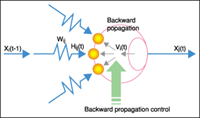  |
 |
 |

|
Elucidation of Principle of "Creating
the Brain"and Its Expression
| Dr.
Gen Matsumoto |
| Group
Director,Brainway Group |
|
 |
We
aim to understand how the brain works from the viewpoint of"creating the brain".
To achieve our aim, we first attempted to clarify the objective of the brain (for
what purpose does the brain exist?), basic principles of the brainユs information
processing and its structurization principles. Then, how these principles are
expressed in the brain is elucidated on the basis of in vitro and in vivo experiments
using neurons and neuronal systems of animals such as rats and squids. As approach
for our research, the hypotheses guiding is adopted.
|
 |
| 1.
The Brain Objective and Its Achieving Principles |
|
1-1.
Objective of the brain
The objective
of the brain is to acquire an algorithm for processing information on its own.
To achieve the objective, it is essential that the brain selects information prerequisitely
by itself. When the objective of the brain is to first select information and
then to acquire an algorithm, we assume that the output from the brain is a means
for the brain to acquire an algorithm. In other words, it could be hypothesized
that the brainユs basic strategy of acquiring the algorithm is output-dependent.
The structurization principle of the brain is also the structurization principle
which constitutes the function to acquire an algorithm called learning and the
brain structure for that function; it is a structurization principle which is
valid in any level of the hierarchical structure, such as a single neuron, neuronal
systems and the entire brain (which means"phychological level". This hypothesis
of structurization strategy, generally called "learning", could be applied not
only for the acquisition of a brain algorithm to carry out its function but also
for its structural expression. From this point of view, the essential difference
between the brain and computers is that their objective and means are merely interchanged.
1-2.
Information principle of the brain
The brain fixes
the acquired (learned) algorithm to be structured as changes in intra- and interneuronal
structure and activity. Therefore, the brain algorithm could be stored as memory
in a look-up table. Information input to the brain is used as a kind of index
to derive some answer from this look-up table. Only when the brain derives (outputs)
an answer does output-dependent learning work to make the derived algorithm renewable.
In this sense, the brain is an information processing system with a memory-based
architecture.
1-3.
Structurization principle of the brain
The "creating
the brain" approach is based on the development process, i.e., on how biological
organisms have phylogenetically and ontogenetically developed. Our hypothetical
definition of an organism is that it is a system capable of creating a nonlinear
nonequilibrium state by itself. Organisms acquire substances, energy and information
selectively, and incorporate them into their bodies in order to self-organize
their structures and functions. If we call the desire to create a selective flow
of substances/energy, and information as "physiological drive" and "linking drive",
respectively, organisms acquire their structures and functions through self-organization
and fix them as information, by establishing behavioral standards and acting according
to these standards in a manner that satisfies the drives. That an organism acquires
an output-dependent information algorithm and performs memory-based information
processing can be considered as the basic principle of not only the brain but
also the general information processing strategy of living bodies. This principle
is consistent in all levels of hierarchies, including brains which have evolved
and developed based on this principle. We are studying how the brainユs structurization
principle is expressed hierarchically in each structural level and what their
characteristics are.
|
| 2.
Brainユs Structurization Principle and Output Dependence |
2-1.
Neuronal level

magnified scene by clicking image
Fig.1
Output-dependent learning model in neurous
|
An
output-dependent learning algorithm at the neuronal level was proposed, and a
mechanism model of the algorithm at the molecular level was studied (Fig. 1).
In Fig. 1, Xi (t-1) is the input from neuron i to j. A synapse (weight; Wij) receives
and memorizes input information as Hij (t) during a fixed period. Backward propagation
of the action potential Vi (t) which occurs at the time of output, increases or
decreases synaptic actively (weight; Wij). The cell memorizes temporal-events-related
information, enabling prediction. Since spatially extended and time-related information
is input in each level of the new cerebral cortex, dendrites in the pyramidal
cells in the fifth layer which penetrate the new cerebral cortex, further acquire
complicated time and spatial information which will be used to anticipate time
and space. Recently, it has been clarified that adrenaline, acetylcholine and
serotonin control backward propagation of action potentials. We consider that
such substances perform learning control at the cellular level and what is called
"reinforced learning" is performed.
|

magnified scene by clicking image
Fig.2
Basic model of sensory information processing in cerebral mammals
|
2-2
Neuronal system level
The cerebrum consists
of a double structure, the archicortex and neocortex, in terms of the evolution
in phylogeny. In other words, the brain of mammals is structurized hierarchically;
a new structure called the neocortex is added to the brain of animals such as
the frog. As a result, the brain quickly processes information through the amygdaloid
complex using a route which directly inputs information from the thalamus to the
amygdaloid complex before the neocortex evaluates the information. This evaluation
is performed extremely quickly; in the case of visual information processing,
the transmission of information from the superior colliculus to the right amygdaloid
complex via the pulvinar is known to be 40 m/sec or less. Results of this quick
evaluation of information are transmitted to the corpus striatum, expressed as
behavior and sent to the inferior temporal lobe (Fig. 2). Pyramidal cells in the
fifth layer in the neocortex expand (project) the nerve fibers that connect the
pyramidal cells in the second layer with those in the third layer. Accordingly,
these nerve fibers begin to form a column by connecting the pyramidal cells with
activated corpus striatum cells. In other words, output from the amygdaloid complex
is roughly set and the function of the neocortex is considered to be structurized
according to the output. This is the formation process of the output-dependent
system of the entire brain network. Furthermore, in the amygdaloid complex, the
values of inputted information are evaluated on the basis of the rough but quick
input interpretation of information. Then the output is expressed in the form
of emotional behavior. This output of emotional behavior controls the brain activity,
and in the output-dependent learning, the neurons possess the characteristics
of proceeding information on the basis of prediction. Therefore, dopamine cells
in the cerebrum basal ganglia are considered to be activated by expectation error
or predicted expectation to reward. Using rats that were trained to perform a
certain task, we experimentally demonstrated that the response after expectation
learning differed depending on the quality of the reward given (either food or
water). |
|
3.
Acquisition of Symbol by Intuitive Information
Processing and Association of Spatiotemporal Information
|
|
Rough
but quick processing of information by the amygdaloid complex is the most primitive
method of interpreting a symbol. Starting from this rough but quick interpretation
of information, the brain acquires the meaning of the symbol by assembling information
of the symbol on the basis of the brainユs double structure and the associations
of spatiotemporal information. However, a mere output response to an input pattern
is insufficient to be called a symbol; symbols must have generalized meanings
(semantic metric). The neocortex and the amygdaloid complex acquire extrinsic
symbols in an output-dependent manner through the expression of endogenous symbols
and processing of actual input from the environment. Rough but quick conceptualization
by means of extrinsic symbol processing in the early stage and associations among
multiple phases is called intuitive information processing. Output is produced
by intuitive interpretation of information. As a result, meaning of symbols are
refined and obtained.
|
| 4.
Conclusion |
| We
continue our study not only on the topics introduced in this paper but also on
topics that may lead to the elucidation of the genes related to the linking drive
("love"genes), as well as their material basis and the physiological events leading
to imprinting of the expressions, using the brains of squids and birds. Furthermore,
the study to clarify the mechanism of how the emotion controls brain activities
is ongoing. In this study, we always attempted to answer the question, "what is
a brain?" to clarify the factors "creating the brain". Therefore, our study indicates
that brain studies are highly compatible with humanities and social sciences which
concern human nature and the social systems by which people can socialize. As
a result, the fusion of brain science, which is categorized as a natural science,
with humanities, social science, philosophy and religion may possibly pave the
way to a new scientific paradigm.
|
| 
|
 |
 |
|
|




